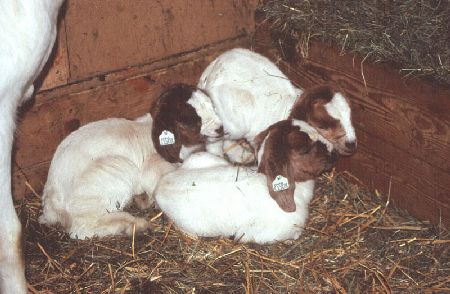Boer goat breeding is still a relatively young branch of business in Austria. The goat farmers and the consultants need figures on the economic viability of keeping Boer goats.
The question of product quality but also the production method is of interest to the consumer. Stable farming is compared to pasture farming. In terms of product quality, qualitative meat quality should also be examined in addition to quantitative meat quality.
This project aims to obtain objective data for the contribution margin calculation for stable keeping and pasture keeping:
- Feed intake and feed utilization of goats and fawns
- Fertility and rearing performance in stables and pastures
- Diseases in stable and pasture farming (rotten limp, stomach and intestinal worms, external parasites)
- Survey of working hours in individual production processes
- High-quality meat from stable and pasture farming (proteins, fatty acids, amino acids, cholesterol, color, shear force, cooking properties, sensory properties)
- Effect of grazing on plant population
Detailed description and goals of the project; Characterization of the novelty and advantages compared to the current state of knowledge
A Boer goat herd of 30 goats and 2 rams is divided into a “grazing” group and a “stable” group. The animals are kept in the stable or on the pastures of the LFZ Raumberg-Gumpenstein. The animals in the stable keeping group are kept in the stable all year round and fed with hay and grass silage in a ratio of 60:40%. A paved outdoor run is available for free adoption.
The grazing group is kept in paddocks during the growing season, whereby the grazing duration should be a maximum of 1 week per paddock. In the winter months, these animals are kept and fed in the same way as the stable group.
The aim of the project is to obtain information about the feed intake of Boer goats in the individual performance stages when kept in stables or pasture. Furthermore, data should be obtained on the fattening and slaughter performance of the fawns as well as the quantitative and qualitative meat performance at different final weights and stable or pasture conditions. Questions about animal health in the two husbandry methods and data about working hours are just as important as the effects of grazing on the plant population.
Feed intake
For the pasture group, the yield is recorded in a selected paddock and the feed intake on the pasture is determined by weighing the remaining growth. Furthermore, plant inventories are taken to examine grazing behavior and the effects of grazing. In the stable, the individual feed intake of the goats and fawns is determined by keeping them in individual boxes or via an electronically accessible concentrate feed station. The goats are offered hay and grass silage to eat freely, with a ratio of 60:40. No concentrated feed is fed to the goats.
The fawns remain with their mothers until they are slaughtered. Some of the fawns are weaned and slaughtered with a live weight of approx. 18 kg, the second part is raised to a live weight of around 30 kg and then slaughtered. The fawns are weighed weekly. The kittens are offered concentrated feed in a concentrate box for free consumption. In the stable group, the individual concentrate intake of the fawns is also determined; this is not possible in the pasture group. Only the total concentrate consumption can be determined here.
Services
Fertility data is collected from the mother animals. The fawns are weighed at birth and at weekly intervals. The dams are also weighed weekly.
The milk production of the goats in the stable group is measured once a week using the oxytocin method.
slaughter
The fawns are slaughtered at the LFZ Raumberg-Gumpenstein slaughterhouse, and the quality of the meat is examined at the Königshof.
The following parameters are recorded on the carcass:
- warm weight,
- pH value 1 hour after slaughter,
- cold weight,
- pH value 24 hours after slaughter,
- kidney fat,
- partial share,
- Meat, fat and bone content of a half of the slaughter.
A meat sample from the leg is examined for the following qualitative parameters:
- water content,
- protein content,
- fat content,
- Cholesterol,
- fatty acids,
- essential amino acids,
- Color,
- shear force,
- loss of dripping juice,
- grill loss,
- loss of cooking juice,
- Sensory properties.
A meat sample from the large back muscle is examined for:
- Marbling
- Intramuscular fat content
Working time records
The time required for all routine work is recorded. However, not from experimental work such as feeding the animals in individual boxes or cutting the carcass into meat, fat and bones.
Health status
A key question is the health status of the two groups. Accurate records of necessary hoof care measures and prophylaxis against internal and external parasites are carried out. The degree of contamination with internal parasites should be determined using fecal sample tests.
schedule
The experiment begins with weaned kittens that are approximately 2-3 months old. This means that the necessary data can also be obtained from the breeding team. The first occupancy occurs at the age of 10 months. An average of 1.6 fawns per mother animal are expected. With a sex ratio of 50:50, this results in an average of 24 male and 24 female animals. In order to obtain a sufficiently large number of kittens for the evaluation, two lambings are necessary. The occupancy is controlled so that lambing takes place shortly before the start of vegetation or grazing. The first occupancy took place in October/November 2002, the 2nd occupancy in October/November 2003.
Months May 2002 to August 2004
|
v |
VI |
VII |
VIII |
IX |
X |
XI |
XII |
I |
II |
III |
IV |
v |
VI |
VII |
VIII |
IX |
X |
XI |
XII |
I |
II |
III |
IV |
v |
VI |
VII |
VIII |
||
|
rearing |
pregnancy |
suckling period |
dry |
|
|
|
|
|
|
|
|
|
|
||||||||||||||||
|
|
|
|
|
|
|
|
|
|
|
|
|
|
|
|
|
|
|
pregnancy |
suckling period |
tr. |
|||||||||
|
grazing period May - October 2002 |
Stable keeping Nov 02 - April 03 |
grazing period May - October 2003 |
Stable keeping Nov 03 - April 04 |
grazing period May - August 04 |
|||||||||||||||||||||||||
Further information on project management can be found in the database for research and sustainable development (Dafne) -> Link







